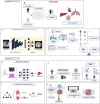The promise of machine learning applications in solid organ transplantation
- PMID: 35817953
- PMCID: PMC9273640
- DOI: 10.1038/s41746-022-00637-2
The promise of machine learning applications in solid organ transplantation
Abstract
Solid-organ transplantation is a life-saving treatment for end-stage organ disease in highly selected patients. Alongside the tremendous progress in the last several decades, new challenges have emerged. The growing disparity between organ demand and supply requires optimal patient/donor selection and matching. Improvements in long-term graft and patient survival require data-driven diagnosis and management of post-transplant complications. The growing abundance of clinical, genetic, radiologic, and metabolic data in transplantation has led to increasing interest in applying machine-learning (ML) tools that can uncover hidden patterns in large datasets. ML algorithms have been applied in predictive modeling of waitlist mortality, donor-recipient matching, survival prediction, post-transplant complications diagnosis, and prediction, aiming to optimize immunosuppression and management. In this review, we provide insight into the various applications of ML in transplant medicine, why these were used to evaluate a specific clinical question, and the potential of ML to transform the care of transplant recipients. 36 articles were selected after a comprehensive search of the following databases: Ovid MEDLINE; Ovid MEDLINE Epub Ahead of Print and In-Process & Other Non-Indexed Citations; Ovid Embase; Cochrane Database of Systematic Reviews (Ovid); and Cochrane Central Register of Controlled Trials (Ovid). In summary, these studies showed that ML techniques hold great potential to improve the outcome of transplant recipients. Future work is required to improve the interpretability of these algorithms, ensure generalizability through larger-scale external validation, and establishment of infrastructure to permit clinical integration.
© 2022. The Author(s).
Conflict of interest statement
M.B. received grants from Paladin, Novo Nordisk, Oncoustics, Natera, MedoAI, Lupin Speakers Bureau: Novartis, Paladin. The authors declare no competing interests.
Figures


References
Publication types
LinkOut - more resources
Full Text Sources
Other Literature Sources

